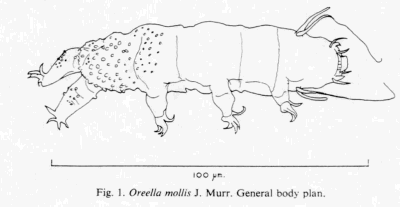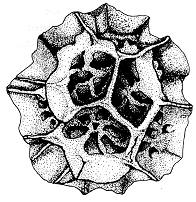|
|
Tardigrada |
| Tardigrada |
Tardigrada |
Tardigrada
Something about "Water Bears"
|
Abbreviated Dendrogram
|
Contents
Overview
Tardigrada
References
|
 "Water Bears"!? No one really knows why tardigrades are called "water bears." It's surely a stupid name. There are a number of explanations for the name in circulation, but the explanations tend to conflict and don't make much sense [1] In any case, it's ridiculous to call a
500µ long (1/50th of an inch) primitive arthropod, which doesn't necessarily live in water, a "water bear." Tardigrades do require a thin layer of water to respire, when active, and they do move in a sort of ungainly, rolling fashion, but the resemblence ends there. Ecologically, they're more like aphids or nematodes, anatomically more like insects, morphologically more like pill bugs, and functionally more like vegetarian vampires. Phylogenetically -- well, who knows? They seem to be near the base of the Arthropoda, but could be more closely related to the "acoelomate" worms.
"Water Bears"!? No one really knows why tardigrades are called "water bears." It's surely a stupid name. There are a number of explanations for the name in circulation, but the explanations tend to conflict and don't make much sense [1] In any case, it's ridiculous to call a
500µ long (1/50th of an inch) primitive arthropod, which doesn't necessarily live in water, a "water bear." Tardigrades do require a thin layer of water to respire, when active, and they do move in a sort of ungainly, rolling fashion, but the resemblence ends there. Ecologically, they're more like aphids or nematodes, anatomically more like insects, morphologically more like pill bugs, and functionally more like vegetarian vampires. Phylogenetically -- well, who knows? They seem to be near the base of the Arthropoda, but could be more closely related to the "acoelomate" worms.
It has recently been learned that tardigrades are very old bugs indeed, with quite distinctive fossils from Siberia dated at about 530 My. Currently there are about 800 known species, although this is undoubtedly a very small fraction of the actual diversity of the Tardigrada. Tardigrades are capable of living in even the most extreme environments due, in part, to an almost unique talent for surviving in a dehydrated, "cryptobiotic" state which they can maintain for years at a time, like instant oatmeal. They are known from every continent, including Antarctica, and every ocean (although the majority of living forms are terrestrial). They normally live in close association with mosses or other vegetation which holds moisture. They have a little straw-like stylet which they stick into plant cells and use to suck out the contents.
Developmentally, they remind one a little of nematodes. That is, the body elements tend to be single, very specialized cells -- lone muscle cells for example. The cells get bigger during growth, but there is little cell division after birth. While tardigrades do have some degree of organ-level development, most of the body plan seems to be nematode-like cell-by-cell differentiation, which may be the original metazoan way.
Tardigrades range in size from 50 (bacteria-sized!) to
1200µ. They have a bilaterally symmetrical, cylindrical body. The head is bluntly rounded, contains the mouth, and may be equipped with sensory probably tactile) cirri. Some tardigrades have a pair of eyes, consisting of a single pigmented cell each. A feature almost unique nemertine worms have something similar) in the animal kingdom are the two calcareous stilettos behind the mouth opening. They use it to pierce their food -- usually moss cells, algae, and sometimes other small animals -- before sucking it out.
The body is short, plump, cylindrical covered with a rather soft chitinous cuticle. Some tardigrades have hard chitinous body armor. The chitinous cuticle is secreted by the underlying epidermis. The muscular system is composed of numerous muscle bands, each a single muscle cell, extending from one subcuticular point of attachment to another. A single, saccular gonad occupies the coelom. Other internal organs are suspended in a general hemocoel. Tardigrades possess eight legs with ventral orientation. The legs consist of simple extensions of the ventrolateral body wall extending ventrally, ending in four to eight claws each.
The digestive system is composed of an anterior mouth with associated salivary glands and stylet apparatus, a sucking pharynx, an esophagus, a stomach or midgut, and a rectum or hindgut, emptying through the anus or cloaca. The mouth is stiffened by rings of cuticle. The salivary glands, stylets, and sucking pharynx are known as the buccal apparatus. After the stylets are extended to pierce plant or animal cell walls, the sucking pharynx draws the cell fluids into the digestive system. The salivary glands are believed to form new stylets at molt. The esophagus ranges from long to short in length. Secretions in the midgut, where absorbtion occurs, are acidic anteriorly and alkaline posteriorly. The hindgut empties through the anus.
The excretory system is composed of a dorsal excretory gland and a pair of Malpighian tubules. The nervous system is composed of a brain, a pair of longitudinal nerve strands, and four ventral ganglia. The brain is composed of two lateral lobes connected by two circumpharyngeal cords to a subpharyngeal ganglion. The ventral ganglia are united by the longitudinal nerve strands. Paired nerves from the brain and ganglia innervate the body. Long strands may have small terminal ganglia.
The reproductive system is composed of a single saccular gonad in a coelomic pouch lying dorsal to the digestive system. In the Eutardigrada, gonoducts open into the rectum. In Heterotardigrada, gonoducts open to the outside through a preanal gonopore. Males possess two vas deferentia, a swollen portion serving as a seminal vesicle. Females possess a single oviduct which passes to the right of the intestine. In accordance with the small size of tardigrades, there is no respiratory or circulatory system.
Reproduction
 Females almost always outnumber males among the tardigrades. This sounds like a good deal for the males, except that some species have learned to do without the males completely and reproduce by parthenogenesis. There is surely a moral lesson in that, but it escapes us at the moment.
Females almost always outnumber males among the tardigrades. This sounds like a good deal for the males, except that some species have learned to do without the males completely and reproduce by parthenogenesis. There is surely a moral lesson in that, but it escapes us at the moment.
Tardigrade eggs are ornamented, and the ornamentation may be unique to the species -- which is helpful in sorting them out. Cleavage is total and apparently equal. Gastrulation occurs by unipolar proliferation. Five pairs of coelomic pouches form. The posterior pair fuse to form the gonad. The others degenerate and form the buccal apparatus and body muscles.
The embryo undergoes direct development. Hatching is accomplished by the piercing of the egg by the stylets and legs. Cell division ceases with birth, and all development thereafter occurs by growth of individual cells.
Ecology and Lifestyle
Tardigrades occur in marine, freshwater, and damp terrestrial habitats. Typically, they are found as part of interstitial communities, on filamentous algae, or inhabiting the surface films of mosses, lichens, and damp forest litter. Tardigrades feed on the fluids of plant and animal cells. A few tardigrades are entirely carnivorous, preying on amoebas, nematodes, and other tardigrades. Most species appear to he eurythermal, tolerating temperatures from near freezing to upwards of 30 degrees C. Food is stored in some epidermal cells. Respiration occurs by diffusion.
Tardigrades frequently display cryptobiosis, a sort of freeeze-dried suspended animation. Anhydrobiosis occurs under conditions of dessication. The animal contracts, loses water, and takes on a shriveled, wrinkled appearance. This "tun" may survive in this state from four to seven years. Animals have been recovered from this state after immersion in liquid helium, absolute alcohol, brine, and ether. Cysts may be formed when the animal undergoes stress in the form of damage, hunger, or abnormal environmental conditions. The animal withdraws into the cuticle and forms a dark, thick-walled cyst. The internal organs undergo some degeneration. The animal reconstitutes in favorable conditions. When deprived of oxygen, tardigrades will enter an anoxybiotic state: the animal swells, the body becomes turgid and movement ceases -- similar to the effect of television on humans.
Eutardigrada: Lack anterior cirri and lateral filaments
Macrobiotidae: Sucking pharynx with macroplacoids
Milnesiidae: Sucking pharynx without macroplacoids, mouth surrounded hy six papillae.
Heterotardigrada: Head with anterior cirri and lateral filaments, four separate but similar claws on each leg.
Echiniscoidea: Stout posterior legs not set off by cuticular folds.
Mesotardigrada: Six similar Long claws on each leg; one species, Thermozodium esakii is from Japanese hot springs.
Notes
[1] We are informed by Thorfin Hallas that the name "water bear" name might derive from one of the first tardigrades described, Acarus ursellus. This just makes things worse. Acarus ursellus means "bear-like mite." Tardigrades are not much more closely related to the mites (Acari) than they are to bears. The mites are probably chelicerates, closely related to spiders.
Descriptions

Tardigrada Doyère 1840 ; Water bears
Phylogeny: Panarthropoda : Mureropodia + (Aysheaia + ((Euonychophora + (Kerygmachela + (Dinocaridida + Arthropoda))))) + *)
Comments: Miniaturized lobopods, convergent on arthropods. Live in moss, leaf litter, damp soil, or freshwater or marine habitats. Capable of astonishing cryptobiosis (dormancy for extended periods) . Fossil tardigrades similar to modern forms, but outside the crown group, are known from the Middle Cambrian Orsten-type lagerstätte of Siberia (Müller et al 2005; CORE - Orsten Research). Milnesium swolenskyi, family Milnesiidae, is known from Cretaceous amber from New Jersey and is barely distinguishable from extant forms (Grimaldi & Engel. 2005 p.97) MAK120430
Links: Wikipedia; Encylclopaedia of Life; Tardigrada Tree of Life; Tardigrade Newsletter - current research on tardigrades compiled by two researchers; Tardigrades - Tardigrada - Bärtierchen (in English & German) ; Tardigrades (Water Bears); Tardigrade appreciation headquarters; Tardigrade Facts; ATW040105, revised MAK120424
Image, from lecture notes by Tom Holtz - Invertebrate Paleontology, Ecdysozoa, Panarthropoda
page uploaded ATW030110, checked ATW040105. Last modified MAK12030
this material may be freely used for any purpose
 "Water Bears"!? No one really knows why tardigrades are called "water bears." It's surely a stupid name. There are a number of explanations for the name in circulation, but the explanations tend to conflict and don't make much sense [1] In any case, it's ridiculous to call a
500µ long (1/50th of an inch) primitive arthropod, which doesn't necessarily live in water, a "water bear." Tardigrades do require a thin layer of water to respire, when active, and they do move in a sort of ungainly, rolling fashion, but the resemblence ends there. Ecologically, they're more like aphids or nematodes, anatomically more like insects, morphologically more like pill bugs, and functionally more like vegetarian vampires. Phylogenetically -- well, who knows? They seem to be near the base of the Arthropoda, but could be more closely related to the "acoelomate" worms.
"Water Bears"!? No one really knows why tardigrades are called "water bears." It's surely a stupid name. There are a number of explanations for the name in circulation, but the explanations tend to conflict and don't make much sense [1] In any case, it's ridiculous to call a
500µ long (1/50th of an inch) primitive arthropod, which doesn't necessarily live in water, a "water bear." Tardigrades do require a thin layer of water to respire, when active, and they do move in a sort of ungainly, rolling fashion, but the resemblence ends there. Ecologically, they're more like aphids or nematodes, anatomically more like insects, morphologically more like pill bugs, and functionally more like vegetarian vampires. Phylogenetically -- well, who knows? They seem to be near the base of the Arthropoda, but could be more closely related to the "acoelomate" worms.

